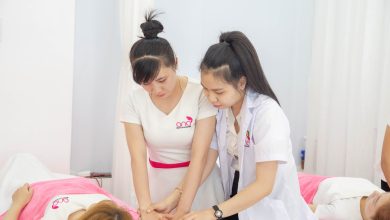What Are Some Common Types Of Knee Injuries?

The knee joint is among the body’s biggest and most complicated joints, and it is also considered to be one of the most vital joints in the body. There are several functions to perform in this area, including sustaining the body weight and making it possible to bend one’s knee while maintaining balance.
The knee joint is vulnerable to a wide range of injuries because of its complexity. Ligament, tendon, and cartilage tears are among the most frequent injuries to the knee joint, and fractures or dislocations of the kneecap may also occur.
Before we discuss the common types of knee injuries, let’s discuss the anatomy of the human knee for better understanding before going for diagnostic services.
Knee Anatomy
Femur, Tibia, and Patella make up the knee joint. The knee joint is made up of the femur(thighbone), patella(kneecap), and tibia (shin bone). For the most part, articular cartilage covers both ends of the leg bones, including both femurs. When you straighten or bend your leg, the knee joint’s cartilage permits the bones to move smoothly against each other. Wedge-shaped cartilage called the meniscus is found between your kneecap and lower leg. In addition to cushioning the joint, the meniscus cartilage works as a shock absorber between the tibia and femur bones.
Four ligaments hold the bones intact in the knee joint and keep it stable. There is a lateral ligament and a medial collateral ligament on each side of the knee joint. When your knee joint travels sideways, these ligaments govern it and stabilize it, protecting it from any unexpected movement. The cruciate ligaments cross over each other in the knee joint and form an “X” shape. There is an anterior and a posterior cruciate ligament, which are placed in front of the knee joint. These ligaments are responsible for the knee’s lateral mobility.
Tendons connect ankle and knee joints. In front of your thigh, the quadriceps tendon is connected to the patella by a ligament. An important part of your leg is the patellar tendon, which links your patella to your lower leg bone.
Common Types Of Knee Injuries
Here are a few of the most frequent knee injuries that need immediate medical assistance.
Fractures
The kneecap acts as a protection for the knee joint, preventing it from being hurt or destroyed in the event of a fall. As a result, the kneecap is susceptible to fracture following a high-impact fall or sports injury.
Kneecap fractures are a frequent but dangerous injury that often needs immobilization and, in some circumstances, surgery to repair.
Dislocations
Dislocations of the knee happen when the bones of the knee become misaligned. This may occur after significant trauma, including a vehicle accident, a fall, or a high-speed collision. Kneeling with one foot on the ground while twisting the knee might also result in this injury.
Dislocation needs immediate relocation. Occasionally, the kneecap may self-correct and return to its natural position. If the knee is relocated, the doctor may need a light sedative for the procedure to go well. A dislocated knee typically takes around six weeks to mend completely.
Tendonitis
Patellar tendinitis is a term that refers to tendonitis or inflammation of the knee. This is a tendon injury that occurs where the kneecap meets the shinbone. Physical activities like running and jumping are made possible by the patellar tendon extending the knee joint.
Tendonitis is a typical occurring injury to an athlete who jumps frequently. Any physically active individual, however, is at risk of acquiring tendinitis.
Anterior Cruciate Ligament (ACL)
The anterior cruciate ligament is a kind of knee tissue that connects the upper and lower leg bones and stabilizes the knee.
You might injure your knee ligaments by overextending or twisting your lower leg. An ACL injury is one of the most prevalent knee ailments, accounting for around 40% of all sports-related injuries.
ACL injuries may vary in severity from a little tear in the ligament to a complete tear or separation of the ligament from the bone. Treatment options for ACL injuries vary according to their severity. Although not all ACL tears need surgery, surgery may be necessary depending on several circumstances, including the degree of the rupture. Following ACL damage, physical therapy is often suggested.
Iliotibial band Syndrome
Long-distance runners often get iliotibial band syndrome, which is caused by the iliotibial band rubbing on the exterior of the knee joint.
Typically, the discomfort begins as a mild irritant. It may progressively worsen to the point that the runner needs take a break from running to allow the iliotibial band to recover.
Injuries to the posterior cruciate ligament
An injury to this ligament may cause the knee to dislocate from the rest of the body. It is one of a number of ligaments that link the thigh bone and shinbone, and this ligament prevents the shinbone from migrating backward excessively.
A posterior cruciate ligament injury needs a great deal of force to occur when the knee is bent. An accident that hits the knee when it’s in an arched position is a common cause of this kind of force.
Collateral Ligament
Collateral ligaments are one of the knee’s four primary ligaments. These injuries are a prevalent kind of sports injury. When the lower leg is twisted sideways, this ligament is readily damaged, and a damaged collateral ligament may not need surgery. However, if other components in the knee are affected concurrently, surgery is often necessary.
Meniscal Tears
The meniscus is a portion of cartilage located between the knee joints that assists in absorbing stress while jogging or participating in sports. The parts serve to cushion and stabilize the joint.
Meniscus tears are prevalent in leaping sports such as soccer and volleyball and contact sports such as football. Meniscus tears may occur when a runner abruptly shifts direction while jogging.
Depending on the amount of damage and the severity of the rip, surgery may be necessary.
Tendon Tears
The patellar tendon – located in the knee – works in conjunction with the front thigh knee muscles to aid leg straightening. While rips in the patellar tendon are more prevalent in adults in their forties and those who participate in running or jumping sports — anybody may rupture their tendon.
When a ligament is completely torn, it is a debilitating injury and needs surgery to restore function. However, most tears are partial and need rest and physical therapy to aid in healing.
Bursitis
Bursae are tiny fluid-filled sacs that provide cushioning for the knee joints and the ability for ligaments and tendons to glide freely across the joint when the knee is bent. Inflammation and swelling of these sacs might occur due to overuse or repetitive pressure from kneeling, and bursitis is the medical term for this condition.
Most bursitis instances are not severe and may be treated at home with simple measures. There are rare circumstances when antibiotic treatment or exercise, which is a technique that involves the insertion of a needle to remove extra fluid, may be required.
Treatment for Knee Injuries
If your knee discomfort is minimal, it’s conceivable that you did not hurt it and that it is just feeling a bit painful due to overexertion. Pain associated with this injury is often treated with the RICE (rest, ice, compression, and elevation) approach. If this strategy works for you and your symptoms return to normal, you may not have to go to the doctor.
Seeing your doctor for treatment is vital if you’re having a great deal of pain, bruising, swelling, or instability. The issue might worsen if the problem is ignored, and a slight sprain could become a major tear.
In order to properly treat your knee injury, among the first measures is to stabilize the knee. Your doctor will almost certainly prescribe that you wear a brace to prevent your knee joint from shifting. Bone fractures will be able to mend correctly as a result of this. In certain cases, crutches may be prescribed to keep you from placing too much pressure on your wounded leg.
Physical Therapy
Physical therapy will consist of a schedule of particular stretches and exercises that will be performed for many weeks in order to restore function to your knee joint. Aside from that, the workouts will help to strengthen the muscles that surround the joint.
Surgical Treatment
Depending on the severity of your knee injury and the extent to which it has been compromised by physiotherapy and other treatment options, you may need knee surgery to restore its function completely. Some injuries, such as a fully torn ligament, are too severe to heal on their own and must be surgically repaired to be effective. Many knee procedures may be done arthroscopically, which means they need just tiny incisions and the use of smaller instruments. If your surgeon determines that a wider incision is necessary to heal the damage, they will create it.





